 Home > CR Interviews
Home > CR Interviews CR Sunday Interview: MK Brown
posted March 8, 2014
CR Sunday Interview: MK Brown
posted March 8, 2014

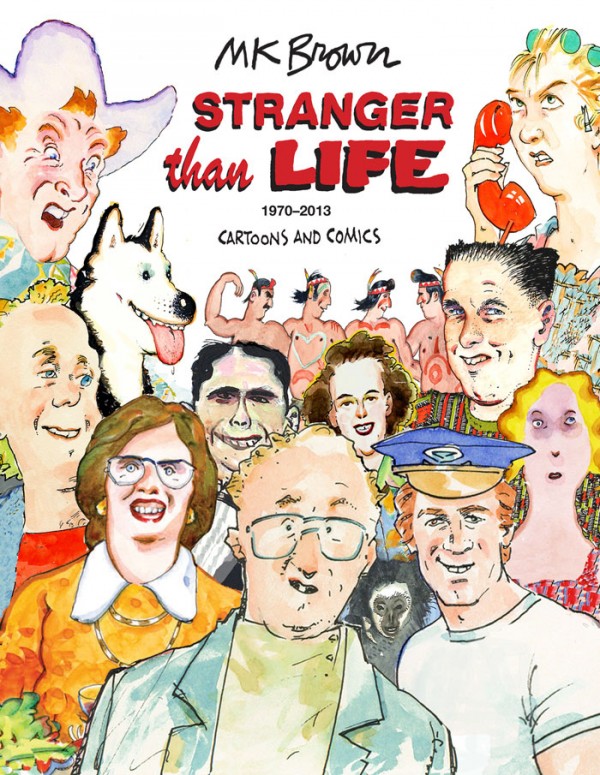
*****
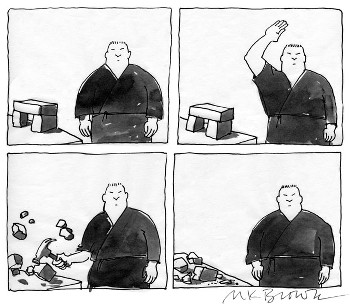
I don't think I'm going to be more surprised by a book during the rest of 2014 than I was by
MK Brown's collection with
Fantagraphics,
Stranger Than Life: Cartoons And Comics 1970-2013. It's not that I didn't know she had made good comics over the year, but I was completely unaware that Brown made
this much material.
Stranger Than Life even leaves out a big chunk of
National Lampoon material that could make for its own collection -- something I hope we see in the next couple of years.
There's no padding to
Stranger Than Life. So much of it is so good. Brown has a natural feel for the kind of raised-consciousness-twist gags on which so much of the best panel cartooning depends after 1960, but she also has a unique sense of color and pacing and very sweet outlook on what people value and why that makes her longer narratives a joy. I spoke to her on a January morning, after spending a week with her collection and I was right up against the "Why are you awesome?" threshold. She took my questions and sometimes random-seeming praise with good humor; we laughed a lot, a little more than I indicate in what follows. I hope some of you will take a look at this book and find it as worth reading as I have. -- Tom Spurgeon
*****
TOM SPURGEON: So how did you develop the book? Because what struck me when I first picked up Stranger Than Life
is how much
work is in there.


MK BROWN: Yes, there is. I know.
SPURGEON: Did you and your editor Gary Groth work together on what might be included?
BROWN: Initially I had planned on two separate books when Gary contacted me. He suggested one big volume and I'm glad he did. These are my favorite cartoons from most of the magazines I've been in, plus quite a few new ones. Putting them into categories was daunting, as you can imagine. I thought that the most generic categories would be best because the work itself is disparate. They are from the early '70s to present. It's quite a stretch.
SPURGEON: The Aunt Mary's Kitchen material wasn't included.
BROWN: That's another whole book. I put in one strip about the beginning of the Aunt Mary character, but including all related material would have been too much. There's the cookbook I did with MacMillan:
Aunt Mary's Kitchen Cookbookwhich I use it all the time, as well as the color strips and the Lampoon Funny Pages series. That, I think, will be a nice volume.
SPURGEON: I assume that Fantagraphics was a supportive partner. Did you seek feedback from them? What about fellow cartoonists?
BROWN: Gary was responsive and helpful all the way through. The layout is basically my own and I scanned everything. I have most of the originals. I wanted to keep them for a show I'm planning for the end of this year. I bought a very nice Epson tabloid size scanner and was able to prepare everything here and make it presentable. Then I worked with Gary's production and design people,
Paul Baresh and
Tony Ong.
Bill Griffith and
Diane Noomin were also very helpful with good ideas when they were visiting.
SPURGEON: How big do you work, MK?
BROWN: It varies, of course. The full-page cartoons are scaled up only a little, like 9 x 12. The image itself on the finished page would by 7 x 10. Not a huge amount of enlargement, but with a few inches of borders, they just too big for a small scanner. This larger Epson works very well for a big page, so it doesn't have to be spliced together.
SPURGEON: That's a chore.
BROWN: It sure is. I've done that before and it can look awful. I can never seem to get it quite right. [laughter] Never the same grade of white. Always a difference.
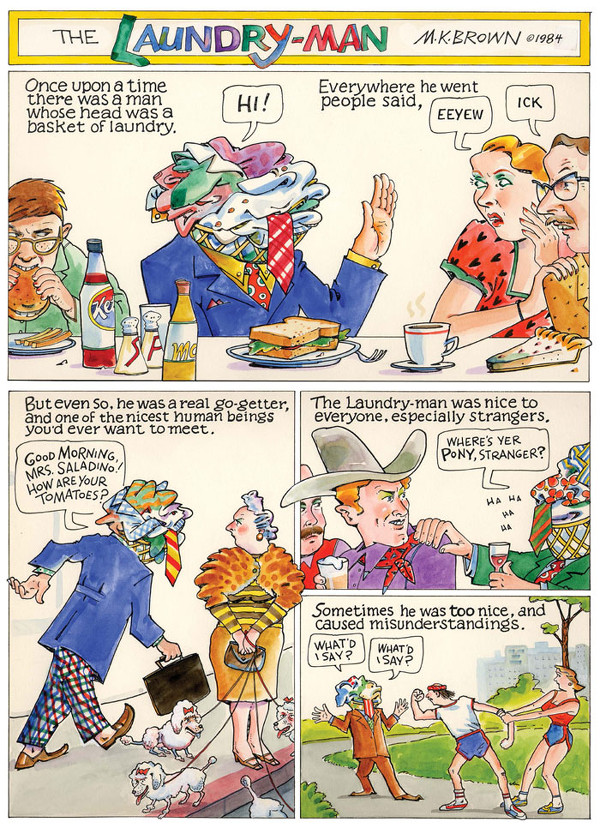 SPURGEON: It's a lovely-
SPURGEON: It's a lovely-looking
book. Your work is visually sophisticated, and I think the book does a nice job of showing that off.
BROWN: Oh, good. Thank you very much. Where did you see it?
SPURGEON: I've just seen the PDF so far -- so we'll leave that as a caveat. If the printed version looks anything like the digital copy, you should be very happy.
BROWN: I am.
SPURGEON: I don't know all that much about your early years. There's a sense in your work of shifting styles. At various time you choose to present
your work in different ways. And yet there's an underlying visual sensibility that connects a lot of what you do. There's not work that isn't recognizable as yours. For that matter, you seemed like a fully-formed cartoonist right out of the gate.
BROWN: I haven't thought about that so much. I've always been drawing or painting since I was little. My brothers and sister and I grew up always drawing. That was a normal way of looking at things for us.
And I always give myself a lot of leeway in whatever art form it is. Nothing to prove. Draw without fear.
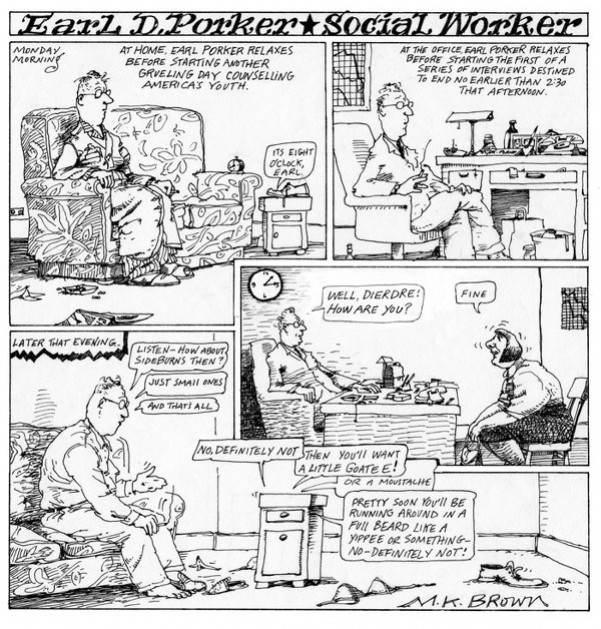 SPURGEON: When you started cartooning, you did a lot of work right away.
SPURGEON: When you started cartooning, you did a lot of work right away.
BROWN: Yes, true.
SPURGEON: So there must have been a way of cartooning into which you locked early on. Or was that just you experimenting on the page?
BROWN: There was a lot of experimenting. And though I loved
Charles Addams and various cartoonists from the Canadian newspapers, I wasn't concerned with having a style. It was just a pleasure to have an art form that fit with my life.
This was when my daughter was a baby and I couldn't paint. We were living in a San Francisco apartment with no studio for me, or long stretches of uninterrupted time. I went into cartooning because it was a satisfying, challenging form I could handle.
I started sending out cartoons to little magazines like
The Realist. They began buying them, and that was the first encouragement.
I was married to
B. Kliban -- who did have a studio -- and had begun to sell regularly to
Playboy. He kept urging me to send a few to
Playboy, so I did and they actually bought some. That was extremely encouraging.
Playboy, of course, has its own particular sensibility. My cartoons were more whimsical than sex oriented, so when I discovered the
Lampoon, that made all the difference.
SPURGEON: You were at the Lampoon
at a really
good period for the magazine. They were killing it.
BROWN: They were. It was so intriguing. So inviting. They were intelligent and funny and dark, but not in a nasty way. Also, they bought everything I sent them. [laughter] which was great, you know. I felt I had found my magazine. That was the real beginning of my cartooning. [laughs] More than
Playboy, though I'll always appreciate
Michelle Urry at
Playboy -- RIP -- and the magazine's care of originals, plus the decent payment for cartoons.
SPURGEON: Were you aware of the Lampoon
before you started submitting.
BROWN: No. I remember the day I saw my first
National Lampoon. Hap [B. Kliban] came home and said, "Hey, here's a new magazine! This is great." It was
The National Lampoon. I looked through it and thought, "Okay. This is where I want to be."
Soon we were both selling to the
Lampoon. They didn't know we were married. Neither did the people at
Playboyuntil much later. I always kept it separate. We were sometimes both on the same page in the
Lampoon, which was kind of funny.
 SPURGEON: You were actually working with a devoted cartoon editor at the
SPURGEON: You were actually working with a devoted cartoon editor at the Lampoon
, am I right? You weren't just working with an art director; there was an editor assigned to that material.
BROWN: Yes.
Sam Gross and
Brian McConnachie were terrific. They were great.
Shary Flenniken was also a fine editor, which was interesting as she was selling cartoons there, too.
SPURGEON: What little of your editorial interactions you've described elsewhere seemed like they gave you a lot of leeway. You'd say what you wanted to do and they'd say, "Go for it."
BROWN: [laughs] Yes, they did. Which was pretty rare. It was wonderful.
SPURGEON: Once you were in the Lampoon
, did you feel like you fit in? Did you feel like you uniquely contributed? Do you feel like part of a group of fellow travelers with the other cartoonists they were publishing?
BROWN: Oh, yes. I really did.
Lampoon had many, many phases as you probably saw. In the early years, it was more of a community. Not that I met many of the people from the magazine in person, I only went to the offices a couple of times, but I was always interested in other people's work.
 SPURGEON: Did you have a sense of the readership at all? Were you getting feedback that way?
SPURGEON: Did you have a sense of the readership at all? Were you getting feedback that way?
BROWN: Yes, I was, and it was a huge surprise. I received some really wonderful letters. It was a new thing for me.
On my book's dedication page I thanked
Dick Daniels. He is a multi-talented artist in Kansas. He has a real eye. In the '70s, he started sending me incredible little gifts as a way to say hello. I'm looking at one right now on my shelf. It's a tiny house with a chimney, built from cardboard with drawn windows and brick detail, that he sent through the mail just that way with my address on the front of the house. [Spurgeon laughs] When you tilt the house, sparkles come out of the chimney. At the bottom is a trap door and inside are vintage cards with iconic images of '40s tricycles and buses and fans.
When the house arrived, hand delivered by the mailman up my 55 stairs, and obviously transported carefully all along the way from Kansas, I was astounded. I asked Hap, "Why did he send me this beautiful thing?" I remember Hap saying, "Because he really likes your work." And I thought, "Oh my God." [laughter] What was so encouraging is that I worried that no one would really think these cartoons were funny or truthful or really get the, um, stranger ones. Then to hear that somebody actually did was a giant relief.
SPURGEON: Looking at the work in Stranger Than Life
, one thing I find interesting is that you're equally adept at these gag cartoons and with cartoons that are quite extended, particularly in the context of mainstream magazine publishing. That made me wonder how you develop an idea. For something that's four, five, more pages, what do you see in it that you think will work over multiple pages like that, as opposed to it being the kind of idea that can only stand a few seconds of time in front of an audience? Is there something about an idea that suggests one approach over another?
BROWN: Hm. I think so. A single panel would be an idea -- a single moment in the brain. I think of it as a statement, a curious fact, a flash of absurdity with truth behind it. The longer pieces often start with an idea I want to pursue. I don't necessarily see where it's going but it's interesting enough to continue. Plus, I want to know the ending.
The lovely part of working with
Lampoon is that I didn't have to do roughs. I could often say, "Okay, I have four pages." And they would let it go and see what happened. I've done children's books that way, too. It's the best way to work, for me., at least that's my favorite way of working. Not that there isn't a lot of actual craft involved in making the spontaneous idea a finished piece.
SPURGEON: So do you write on the page?
BROWN: I do a pencil drawing, a very tight pencil drawing first. on layout paper. I let one thing lead to another and have the lettering pretty much scoped out... and the ending... and the in-between scenes-- It's complete, in pencil. And then I use a light table and transfer it lightly in pencil to hot press Strathmore, and ink it, then color, if called for.
 SPURGEON: The dream strips. The "White Girl Dreams" strip. It's almost an essay style you're using here. There aren't the hard progressions like with a comic strip narrative. Do you remember developing those, doing those?
SPURGEON: The dream strips. The "White Girl Dreams" strip. It's almost an essay style you're using here. There aren't the hard progressions like with a comic strip narrative. Do you remember developing those, doing those?
BROWN: I do. [laughs] I had just finished an animation job for TV. Everything had to be scripted and nailed down, and I never knew how it would look until I saw it on the screen with everyone else. It was very, very difficult for me. This was my way of forgetting about TV. [laughs] It was doing something for myself.
I just let it start, and enjoyed having one drawing lead to another, one page to the next -- I didn't use pencil drawings for that one, It was ink from the start, on the expensive paper.
SPURGEON: A lot of your humor comes less from the quality of the drawing than the fact that a certain outlandish element is played against a conservative background. But you also have the capacity at any time just to make a funny drawing.
BROWN: I can't help it! [laughter]
SPURGEON: Is it pleasurable for you to draw that way?
BROWN: Oh, sure it is. Of course it is. I love to do that.
SPURGEON: Do you laugh at your own comics?
BROWN: Uh-huh. [laughs] I hate to admit it, but yes, I do. In fact, when I saw the book for the first time and went through it, trying to be objective, I thought, "Oh Lord, where did
that come from?" [laughter]
SPURGEON: A lot of your work functions as satire, but I wonder if there are specific things you prefer to target when writing that kind of material, a particularly hypocrisy to which you're drawn. Is your work best understood as pushback against American conservatism of the '50s on? Is that tight-assed milieu a rich target environment for you? Do you feel like your work exists as a commentary on restrictive aspects of culture?
BROWN: Having grown up in conservative Connecticut, that kind of pushback did happen, especially at first. I don't know how my work is understood. I hope there is a quality that reaches out because, from my point of view, it's as truthful a commentary as I can make.
I don't necessarily want to say something explicitly, but I can use the medium to express it, metaphorically speaking.
In that sense, cartooning has been therapeutic. When something disturbs me I can do a cartoon about it. I can make it as funny or as horrendous as I want. It really helps and I recommend this to everyone, whether you can draw up to your own highly critical standards or not.
 SPURGEON: The anecdotal material you do... one that springs to mind is a story about your dentist. Is that an experience you've had? Or is that you developing a situation for comedic use?
SPURGEON: The anecdotal material you do... one that springs to mind is a story about your dentist. Is that an experience you've had? Or is that you developing a situation for comedic use?
BROWN: Well, it's both. I was upset with my former dentist. [laughter] Very upset. And with his Swedish assistant, too. I started that cartoon to make myself feel better, to change roles with my dentist and let him have it. Writing it, drawing it, with all the lurid details did, indeed, make me feel a whole lot better. Others seem to have identified with it also.
SPURGEON: Were you formally educated as a painter?
BROWN: Painting was my main interest in art school. That's still very much a part of my life.
SPURGEON: Is there anything you have to unlearn to work in cartooning after being trained as a painter?
BROWN: No. They're very different. They're both important, both hard to do. They both take a lot of skill. They are extremely pleasurable. They're just different.
SPURGEON: What is something that's hard for you to do in cartooning?
BROWN: Setting up the pages and getting the lettering correct. Laying it out. Also figuring out how something is going to end. Getting the writing correct -- eliminating unnecessary words. The practical part.
 SPURGEON: Your writing is very lean.
SPURGEON: Your writing is very lean.
BROWN: Thank you.
SPURGEON: I imagine that might be the influence of the single-panel cartoons. That would seem to require the strictest control in terms of verbiage.
BROWN: You are right. The less words the better.
SPURGEON: Do you go back over comics and cut words?
BROWN: Oh, yes, very much so. It's necessary and feels good to condense. It reads better, too.
 SPURGEON: When I told a friend of mine I was interviewing you, she made me promise I would try to get you to talk about color a bit. I would assume your painting background plays into your color sense. As you've worked with color for cartooning over the years, have you made any discoveries as to certain approaches that might work better than others? How much trial and error has there been?
SPURGEON: When I told a friend of mine I was interviewing you, she made me promise I would try to get you to talk about color a bit. I would assume your painting background plays into your color sense. As you've worked with color for cartooning over the years, have you made any discoveries as to certain approaches that might work better than others? How much trial and error has there been?
BROWN: With painting, there are no limits. For cartoons or illustrations, I take into account how it's going to be reproduced. I prefer the clearest, brightest colors possible, then work with them.
For any printed material, the final color is sometimes going to be a little less vibrant than hoped for. Sometimes the
Lampoonprinted on absorbent paper that wasn't coated, and the colors were compromised. This didn't happen often, fortunately, but now and then there were disappointing results. I had to plan ahead and make it as bright and as deliciously rich as possible, without being garish.
I've always used Windsor-Newton watercolors with my favorite palette developed over the years, for cartoons and for paintings with oils and acrylics. I guess I'm kind of stuck in that range of color. [laughter]
SPURGEON: Are there ways in which your cartooning hasn't stayed the same? How open are you to being influenced, both with color and more generally?
BROWN: In retrospect, and in a subtle way, Hap and I influenced each other at the beginning. He started crosshatching and adding more detail as I was doing, and I started simplifying, more like his drawings, which were generally in a clear strong line. We kept our own flavor, but there was a cross pollination.
As far as color goes, I don't remember ever seeing anyone's colors I wanted to emulate though I'm sure that happened a lot without realizing it. The palette I favor is a personal choice. It's very subjective --I just like these colors! [laughter]
SPURGEON: One of the nice things about your color work is that vibrancy; they look nice, above and beyond their ability to set a mood or establish a tone.
BROWN: Oh, good. Thanks.
SPURGEON: Like in your western section.
BROWN: "Western Romance." [laughs]
SPURGEON: That page in particular seems like page after page of stop-and-stare color imagery. There's one where she's stuffing a turkey and the apron and the hair and there's a calendar… You know, you said you found some of the work affecting when you returned to it, but was there any insight available to you by looking at that older work? "Oh, that's what was going on with me."
BROWN: Sometimes they are more revealing than I realized while drawing it.
I don't know what to say about that. I never wanted to do really personal things. And yet it all seems to come out in metaphor. [laughs] That's another story.
SPURGEON: Because of when you were working and the breadth of your career, one way people are going to look at you is as a woman cartoonist. You've spoken well of other Lampoon
cartoonists and for your husband as an artistic fellow traveler; did you also relate to the other women making comics in your generation?
BROWN: Well, yes indeed. I really enjoyed meeting the other women cartoonists who were in Diane Noomin's books,
Twisted Sisters. That was fun. We had a fabulous show of originals at
La Luz De Jesus in Los Angeles. It was wonderful meeting all the other women cartoonists whose work I admired.
I never thought of myself first as a woman cartoonist. It's hard enough to do something funny and truthful while holding to a certain stance. I tried! But it never came naturally to me and I gave it up fast.
I sold a lot of work to
womenSports and
Mother Jones, but even so, they weren't particularly feminist cartoons. Luckily,
Louise Kollenbaum was at
Mother Jones then and defended me.
SPURGEON: Was "MK Brown" in part a screen for you to take gender out of how people were looking at your cartoons?
BROWN: It started at art school when I sent paintings to juried group shows. I found that when I signed my whole name I wasn't accepted as often as when I used my initials. It became a habit, of course.
SPURGEON: You didn't publish at National Lampoon
throughout. You were an intermittent contributor.
BROWN: At the end in particular I dropped out. There were a couple of years... I'm not sure what was happening editorially, but it was something I didn't like, so I quit for a while. It was great while it lasted.
SPURGEON: You did go back for that '80s run.
BROWN: I did go back for a while. Occasionally the editors changed and hope returned.
SPURGEON: Was it noticeably different to work for at that time?
BROWN: Most of the editors who were there at the beginning had left. So it was very different. But it was a venue, a place to sell cartoons, and there weren't that many then. I hadn't sold anything to
The New Yorker at that point. It was only later that a few were accepted.
 SPURGEON: Do you feel like there's a place for you in an increasingly graphic novel-oriented world?
SPURGEON: Do you feel like there's a place for you in an increasingly graphic novel-oriented world?
BROWN: I've thought about doing one, but the right idea hasn't struck. I have some ideas that are long-ranging, but whether I want to start such a project? I'm not sure.
SPURGEON: That seems like a strong through-line for your career, though, that you've pretty much done what you've wanted to do and found a market for it. Has there ever been any element of anticipating what might sell?
BROWN: I've given up being practical long ago. No, the best work is when I respond to what I want to do, more than anything. Even now, when there's no real market for them, I get ideas for single panels and I kind of try not to, in a way. [Spurgeon laughs] If they persist, I do a little sketch, and I've got them for later. What I will do with them I don't know. Maybe another collection. Or I'll include them in a new national humor magazine and website that seems to be cooking.
One project sitting there is an illustrated short story called "Wolf Boy." There will be two other short pieces like it for a book. That's probably as close to a graphic novel as I want to get.
SPURGEON: I was struck looking at your work how much I like your lettering. It's very expressive. It makes the gag strips slightly disappointing when they don't have your lettering. [Brown laughs] You seem to make use of it as an expressive tool.
BROWN: It is!
SPURGEON: In "Western Romance" it seems like there are several flourishes that come straight from the lettering.
BROWN: Hand lettering is like a voice, isn't it? It immediately conveys what you want to say and then can be exaggerated, or, with a flourish or two, become a grace note -- like subtle inflections of a voice.
I worked for my calligraphy teacher from
Silvermine Guild School of Art for several years during summers and vacations who had a commercial art business. I did lettering for all kinds of big events and learned a lot about calligraphy then.
SPURGEON: The colored effect you sometimes use in "Western Romance," where the line itself is colored, is there a specific effect you're trying for there? Is there any element to simply enjoying the visual nature of letters on the page that way?
BROWN: You're thinking of within the synopsis, probably. Yes. That's to emphasize and draw attention to a particular word. It's also to enliven a large page of text beyond simply using black and white lettering. Because there were months between one chapter and the next in "Western Romance," the synopsis grew longer and longer, thus more need for illuminated lettering.
SPURGEON: You've talked a little bit about this, but what was it like on a personal level in living that closely to so much work from such a range of dates for months at a time as this book finally came together.
BROWN: A big collection was something I've wanted to do for a very long time, before going on to other projects, so I was focused and determined. But the process of scanning and closely examining work from years ago, brought up memories. You know how they can be. Luckily, most of them are happy, but then I do try to remember the good parts and forget the rest.
I recently heard a quote from
Lama Surya Das which struck a chord: "Forgiveness means letting go of the hope for a better past."
*****
*
MK Brown's Site
*
Stranger Than Life: Cartoons and Comics 1970-2013, MK Brown, Fantagraphics, softcover, 248 pages, 2014, $35.
*****
* cover to the new collection
* gag strip I like
* one of the very pretty pages throughout the book
* what looks to me like early work, but if it isn't, I still like it
* one of the MK Brown comics for which Sam Gross was editor
* a random humorous illustration
* "White Girl Dreams"
* that dentist comic
* three different pages showing off Brown's approach to color
* more of a random gag panel of the various types of work included in the collection (below)
*****
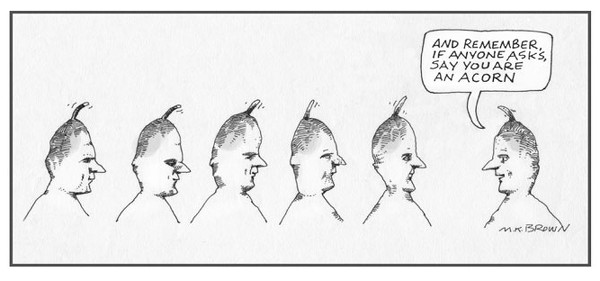
*****
*****


